
13th – 27th April
For many, many years people have raved to us about how wonderful Lawn Hill Gorge is (Boodjamulla National Park), and finally, finally we’re going to see it for ourselves. From Mt Isa we headed north on the Camooweal Rd, another really bad road, to Miyumba camp, the southern-most camp in the National Park. The road was rocky, and when not rocky, it was corrugations, plus a few water crossings thrown in for good measure. We drove ‘according to conditions’ and arrived intact.

The final water crossing, just 100m short of our camp was over the Gregory River. It was flowing quite swiftly, about shin deep – no drama for Priscilla. Once camped (only ones there) we walked back to the river and had a lovely, cool, spa bath right there beside the road.

The night was magic – no lights, no moon and millions of stars from horizon to horizon. These are the nights we especially love.
14th – 17th April Boodjamulla NP

Next morning, continuing north, we stopped at the Riversleigh World Heritage site renown as a dinosaur fossil site. It’s very well presented and interesting with large fossils evident in the rocks along an 800m path.

The gorge part of Boodjamulla is 55km north. A large commercial campsite at Adels Grove, just outside the NP, provides accommodation for the on-road vehicles and caravans and those who didn’t book early enough to get into the NP. The National Park campsite is 10 km down the road at the Gorge. The road was improved significantly.
Over the next 4 days we did a twilight walk up to Duwadarri Lookout completing the circuit via Indarri Falls, a walk to the Cascades, then back to walk to the Upper Gorge. These walks were lovely in places, stunning in others and difficult in parts, but well worthwhile. Another day we took the kayak up the river, marvelling at the stunning cliffs through which we paddled.
At Indarri Falls we ‘portered’ the kayak along the path to bypass it, then continued right up to the Upper Gorge where we found a fabulous landing spot at rapids where we stopped for lunch, a swim and a massage under the rapids. We were lucky to have the place to ourselves for more than an hour. On our last day we kayaked up to Indarri Falls then spent quite a few hours there, swimming, getting massaged by the falls, chatting to other kayakers, relaxing and staying cool.

We both enjoyed Boodjamulla, and while a longer stay wasn’t necessary, I wouldn’t mind coming back another time. The only thing that spoilt our visit was the weather – it’s very hot, 35/36° for the first 3 days, cool breeze on the last.
19th – 22nd April
We saw the Gulf of Carpentaria from the west in our Arnhem Land trip in 2019 and now, heading to Karumba I’m planning to get my feet wet in the eastern Gulf. But first the drive from Boodjamulla was pleasant on good unsealed roads, just a few small washouts and corrugations as we traversed the grass lands stopping for a coffee and a highly-touted muffin at Murray’s Place in Gregory. From here we headed north (on sealed roads) to Burke for a look around town, sitting in a park having lunch at the same time the ABC News that night informed us it was the hottest town in Queensland! Back south again to stay the night at Leichhardt Falls.
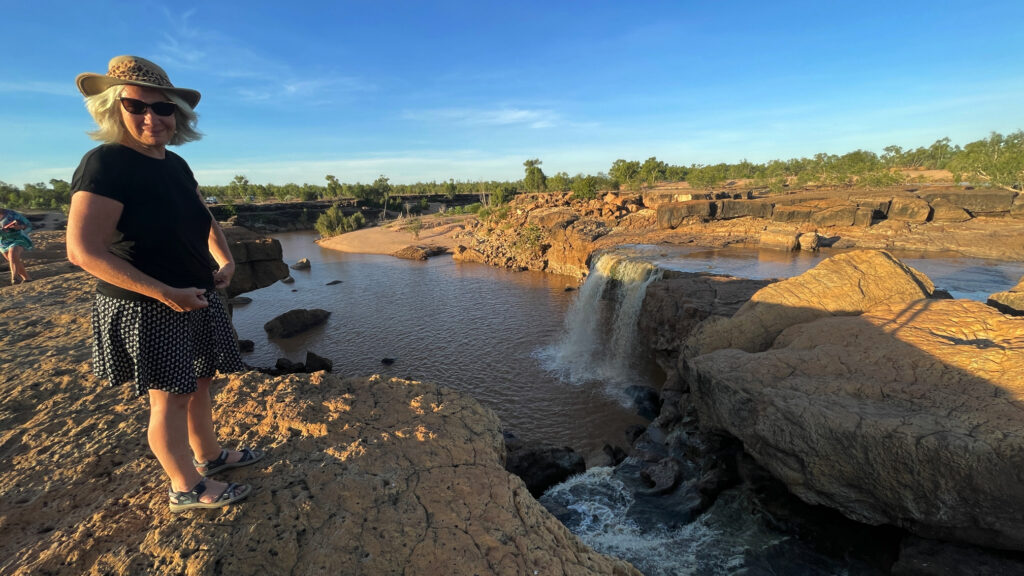
Leichhardt Falls, on the Leichhardt River is not much more than a puddle during the dry season, but at the moment the water is roaring over the falls. A croc was spotted just down from the base of the falls – no swimming! Watching the road trains navigate the long, single-lane bridge that crossed the river gave me an even greater respect for those drivers.
Not a long drive today. The road to Karumba is unsealed, but mostly pretty good. At Camp 119 we viewed the blazed trees and read the story of Burke and Wills most northerly campsite. They tried to walk further on to the coast, but as it was the wet season (crazy!!) it was too swampy to reach.
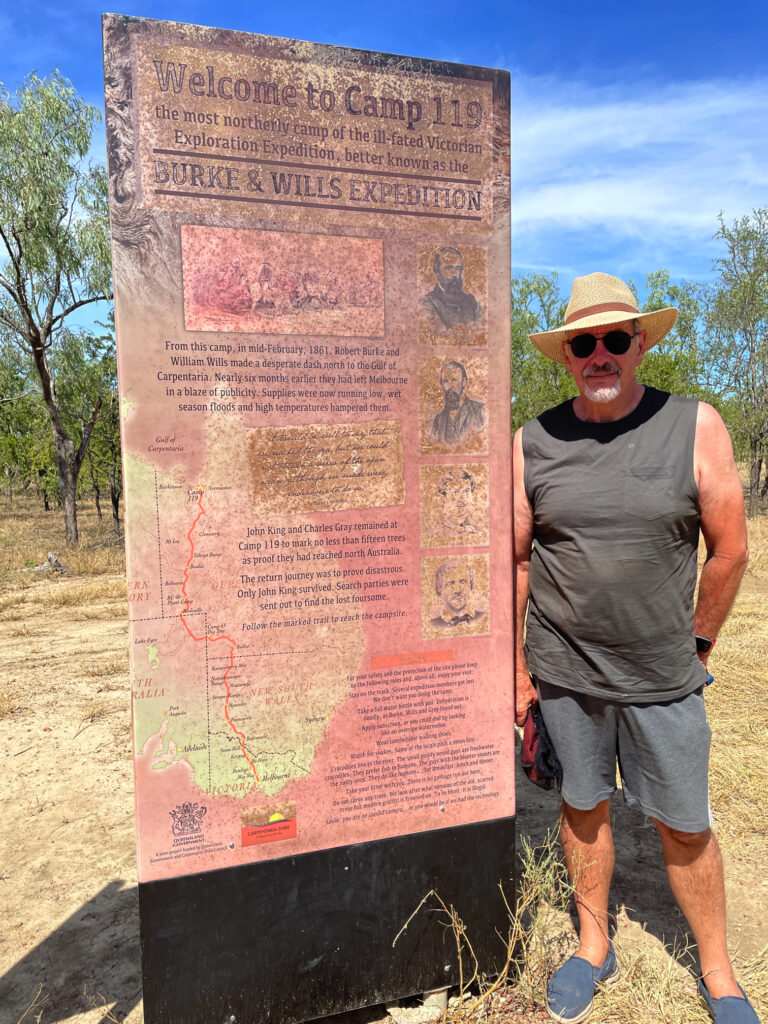
Another rest stop at Normanton proved interesting for not only the story of Krys, the largest crocodile ever, but also the Information Centre told the story of the beef industry here and the important role of the native stockmen.

A cruise on into Karumba was easy driving before we found our campsite at Ronnies and settled in. First point of call was to buy prawns for our lunch.

Karumba exists to service the commercial prawning trawlers, the commercial barramundi fishers, to a lesser extent the export of zinc from Century mine and, of course, tourism. The prawning industry started in the early 1960’s when a wealthy businessman managed to talk the CSIRO into jointly funding an exploration in the Gulf and the highly sought-after banana prawns were found in abundance.
The purpose of the Barramundi Discovery Centre is to maintain the stocks of barramundi by breeding them to fingerling size then releasing back into the wild. It was begun some years ago by the local commercial fishermen who saw the need to protect the barramundi from over-fishing. Smart move! The Centre was recommended to us by other travellers and I must say it is really interesting and not to be missed, though the tour at $50 each, was overpriced.
Karumba has been recognised for their efforts to maintain a sustainable seafood industry. Well done Karumba.
While here we did a sunset cruise (so so) and enjoyed meals at the End Of the Road restaurant one night and the Sunset Tavern another – seafood meals, of course, while sipping cocktails and watching magnificent sunsets.

Road closure due to flooding changed our route of departure to the sealed section of the Savannah Way – traversing rich grasslands once more.

22nd – 23rd April
The highlight of a night at Gilbert River West (free camp, no facilities) was seeing the foaming waters of the river in flood, not far beneath the long one-lane bridge.

Next morning we moseyed on into Georgetown to stay at the CP, the power giving our batteries a boost. A walk around town left us with the impression of a small town with plenty of pride.

24th – 25th April
On towards Cobbold Gorge over unsealed roads in pretty good condition with just a few shallow water crossings. On the way a cuppa stop at Forsayth and a wander around town found this town to be as impressive as Georgetown with its beautiful, restored buildings and well-tended parks.
I was very excited to get to Cobbold Gorge – the photos I’d seen of the gorge were stunning and it didn’t disappoint. The beauty of the narrow gorge (only about 2 meters wide in some places) was only discovered a few years ago by the current owners of Robin Hood Station, the cattle station it is in.
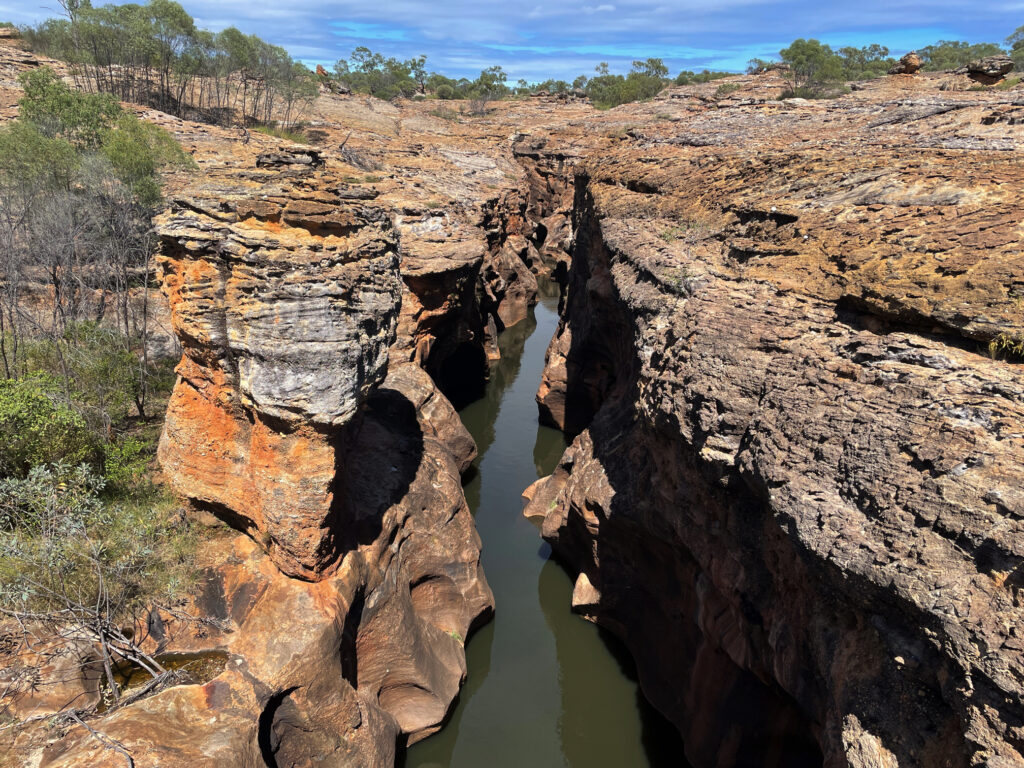
A LOT of private/public funding has gone into developing the tourist facility here which includes a large reception area with souvenirs, a small grocery stocking basics, a large open-air restaurant beside the pool which has a swim-up bar, a function hall as well as very well laid-out RV and camping areas.
Apart from the Gorge itself there’s a large dam with free kayaks, several bush walks and mountain bike trails (BYO bike) and some four-wheel drive tracks to points of interest and the gem fields (agate mostly).
On our first afternoon, after settling in, we did an 8km walk up to a lookout, then back for a swim and cocktail at the swim-up bar.

The Gorge is several kilometres away from the resort and only accessible on tours in an effort to maintain its pristine condition. We did the boat tour next morning. The guide was particularly good sharing historical, geological and botanical knowledge with us. The boat, an open punt, has a silent electric motor.

It was a stunning experience with the walls of the gorge towering up beside us, close enough in places to touch both sides at the same time, while we glided silently along. Back at the start we then walked up onto the huge sandstone rock that encloses the gorge, crossing over the gorge on a glass bridge.

That afternoon we’d signed up for the SUP tour. If this morning’s tour was stunning, the SUP induced awe. This morning’s boat held 14 people, plus the guide and while everyone was quiet, just soaking it all in, the guide, naturally talked a fair bit. With the SUP there were only 7 of us and we all headed off separately, so Steve and I were able to enjoy the gorge more or less alone. It was every bit as wonderful as I’d hoped – and I didn’t fall in!
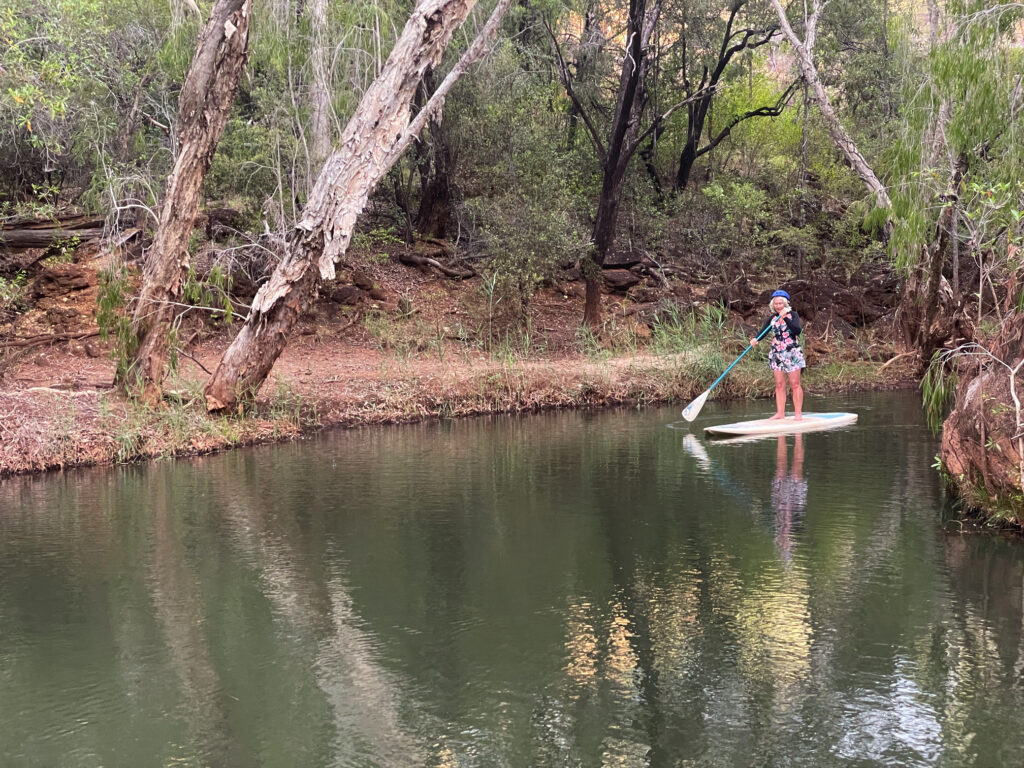
26th – 27th April
Leaving Cobbold Gorge we did one of their 4-wheel drive trips up to the Quartz Blow – a hill of beautiful white quartz which gave us views across to the horizon all around.

We’d asked around about the road through to Einasleigh and been rewarded with a shrug and “it’s OK”, so off we went, and it was “OK” – some bitumen, some corrugations, some washouts – OK. What we failed to ask about was the road from Einasleigh to the Gregory Developmental Rd! The Einasleigh River was over the causeway and flowing pretty fast.

As all good 4x4ers who don’t want to walk a river crossing do, we parked to the side and made ourselves some lunch and a cuppa. Sure enough 3 vehicles came down and we watched them cross, noted where it was washed out, noted their track and safely followed on.
Kalkani Crater, a very typical cone-shaped hill with a perfectly round rim that drops away into the middle was a great little walk on our way to the Undara Experience, the resort set up at the Lava Tubes.
Undara Experience, the accommodation associated with the lava tubes, was moderately busy as a music festival had just finished yesterday. It’s quite a resort here with lots of units, and heaps of powered and unpowered camping, a large open air cafe / restaurant, pool … you get the idea.
“The lava tubes and caves were formed when rivers of lava confined to a valley crusted over and formed a roof. Insulated in its casing of solidified lava, the lava flow carried on for tens of kilometres before draining out, leaving an empty tube of lava. Weaker sections of the roof of the tubes later collapsed to form caves and depressions. More than 70 caves have been found in the park.” (Text from NP literature) The lava flowed more than 90km to the north and 160km to the north-west at a rate of 1,000m3 per second!
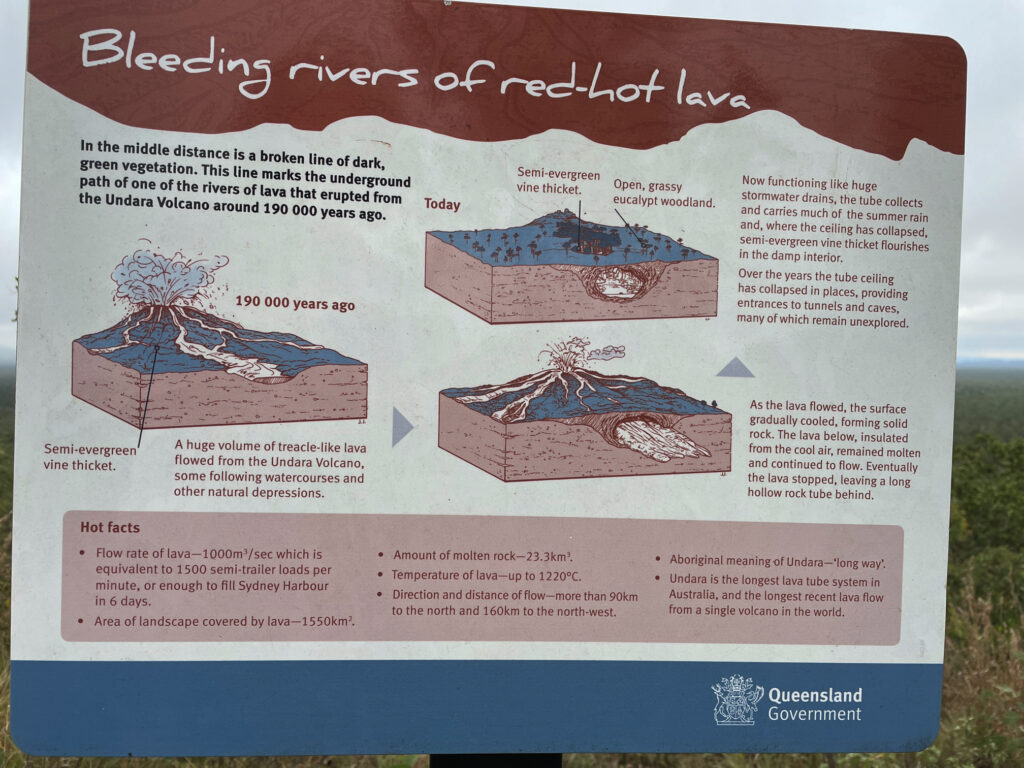
Access to the caves is restricted to approved scientists, speleologists and guided tours. The area has received 3 times its usual annual rainfall in the last few months and the caves have been full of water, a rare event. We had the amazing experience of walking through the caves on the walkways with crystal clear, chilly water up to our shins.

There are several bush walks starting from the camping ground, the longest being the Rosella Trail at about 14km. This trail took us to several lookouts from which we could trace the track of collapsed tubes by the bright green vegetation that grows in the protected stream bed.